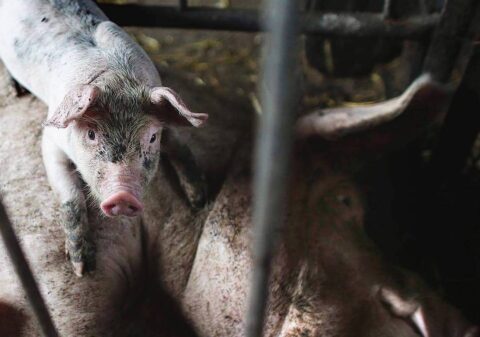Perspective
Critics Declared Veganism Dead in 2025. Here’s What Those Obituaries Are Missing.
Food•5 min read
Perspective
Millions of farmed animals were needlessly put to death during the pandemic. It doesn’t have to be this way.

Perspective • Food • Industry

Words by Karen Estensen Rubio
In a recent CNN report, Minnesota hog farmer Doc Hoehm stood next to his son and said, “We put down sick pigs because you feel sorry for ‘em.” His voice choked with emotion, he continued, “But to have a healthy pig, and to take a rifle and shoot it… It’s unreal.”
In April and May, as COVID-19 continued its tear across the United States, infections and deaths of workers and USDA inspectors soared, and more than 20 U.S. slaughterhouses closed as they became hotspots for virus transmission.
The Hoehms’ hog farm typically shipped 700 hogs every week to a Smithfield plant in Sioux Falls, South Dakota. As the weeks dragged on, they tried to keep their hogs’ weight down by restricting their diet, a corner-cutting method used by many farmers during the crisis. Then they started to run low on money for feed.
And so the Hoehms, like thousands of other farmers across the country, ran out of options. They started killing their animals.
While the Hoehms declined to state how they killed their pigs, several reports from other farms state that farmers are piping hot air and carbon dioxide through barn ventilation systems, known as ventilation shutdowns or VSD. Animals die from a combination of suffocation and roasting to death after hours of suffering. In other instances, farmers are shooting pigs in the head to make room for new arrivals.
In May, Iowa Select Farms in rural Grundy County near Aplington, Iowa, decided to mass kill their surplus pigs through VSD. An employee, disturbed by the cruelty, contacted Matt Johnson, an investigator with Berkeley-based animal rights group Direct Action Everywhere (DxE). In a gut-wrenching video taken May 19, workers are seen sealing the barn shut and pumping in superheated steam. Pigs can be heard screaming in agony. This goes on all night; in the morning, workers dispatch any survivors with a captive bolt gun. (This video includes graphic images and sounds some readers may find disturbing.)
Across the factory farming industry, the body count is rising, and it’s not just pigs. The lack of employees at chicken processing plants is causing the mass slaughter of several million chickens nationwide. Some are being killed through ventilation shutdown. Others are dying an alternative but equally excruciating death: Workers release a rolling carpet of fire-fighting foam on the frightened birds, suffocating them as they struggle to escape.
A quiet mass extermination is taking place across America with tens of millions of animals being shot, gassed, or bludgeoned because they are no longer profitable. According to the Guardian, more than 10 million hens have been killed, and 10 million pigs will be killed within the next four months.
What happens to all these bodies? Some animals are buried in mass graves or simply left in barns with dirt bulldozed over them. At a dumping site in Minnesota, dead pigs are being ground up in industrial wood chippers with wood chips or straw, piled into mounds for composting, and then spread onto vineyard fields.
How did we arrive at a place where such atrocities are not only committed but deemed “humane” by the very industry that commits them?
COVID-19 has exposed the seamy underbelly of industrial agriculture, and it’s not a pretty picture. The green pastures and tidy barns of our memory are a far cry from today’s industrialized farms, where animals suffer in tightly packed, sordid conditions.
In the last half-century, the consolidation of food production has concentrated power into the hands of a few mega-corporations that produce food with little-to-no regard for the environment, food safety, and animal welfare.
These big meatpacking companies like JBS, Tyson, Cargill, and Smithfield outsource the least profitable and most difficult part of the business—the farms—to farmers who often struggle to make a living. Farmers sign contracts to raise company-owned animals on land they do not own, forcing them to take out crippling loans to build company-specified barns and pay back their employers for any animals they lose to illness. These “contract growers” often accrue significant debt or risk losing their homes after finding their contracts aren’t as fair or profitable as they were promised.
Slaughterhouse workers are even worse off. When President Trump declared meat an “essential item” and invoked the Defense Production Act at the end of April, slaughterhouse workers were ordered back to work during some of the pandemic’s worst outbreaks. Meatpacker Tin Aye was a 60-year-old refugee who came with her family from Burma in hopes of a better life. When Aye, a 12-year employee with the JBS meatpacking plant in Greeley, Colorado, started feeling sick, she went to the company clinic. “Oh, they just told me I have a normal cold and I have to go back to work. I go back to work,” she told her daughter by phone. Weeks later, Aye passed away from complications brought on by COVID-19 without seeing her son, a Marine who was rushing home from South Carolina to see her, and without ever meeting her newborn grandson. To date, at least 43,902 workers have tested positive for COVID-19, and at least 167 workers have died.
Americans aren’t just being kept in the dark as to the true extent of our broken and unjust food system; they’re also picking up the tab. While Big Meat conglomerates reap the profit from livestock production, taxpayers pay for cleaning polluted water, health care for asthma, and other public health crises associated with factory farms. According to David Robinson Simon’s seminal report Meatonomics: The Bizarre Economics of Meat and Dairy, Americans pay $38 billion per year to subsidize animal agriculture, masking the true cost of using animals for food.
Today, America is paying a staggering toll for its traditional reliance on meat, dairy, and eggs. “Simply put, animal agriculture is destroying our land,” says Lori Ann Burd, Senior Attorney at Center for Biological Diversity. “Thirty-six percent of crops grown on Earth are for livestock,” she explains. “Corn uses the worst practices. It requires tons of nitrogen, creating vast dead zones in the Gulf. It requires pesticides such as Roundup (glyphosate) and atrazine, a toxic endocrine disrupter.”
According to a 2019 report issued by the Environmental Integrity Project, a stunning 96 percent of slaughterhouses are in violation of wastewater regulations; the EPA has since been sued for failing to enforce effluent standards.
COVID-19 has cracked open the world of factory farming, exposing all its cruelties and inequities: low wages and dangerous working conditions for its workers, crushing misery on the part of small farmers, and misplaced trust from the general public.
America’s reliance on meat, dairy, and processed foods is exacting a heavy toll on our environment. Animal agriculture is responsible for air, land, and water pollution, species extinction, deforestation, ocean depletion, and dead zones, and a warming climate that is accelerating drought, flooding, fire, and other extreme weather events at alarming rates.
It’s also making us unhealthy. Most experts now agree that eating a diet high in meat, dairy, and highly processed foods contributes to a host of preventable diseases: heart disease, stroke, diabetes, some types of cancer, osteoporosis, obesity, and more. As leading nutritionist Dr. Michael Greger bluntly put it, “Fatty streaks, the first stage of atherosclerosis, were found in the arteries of nearly 100 percent of kids by age ten who were raised on the standard American diet.”
The traditional American diet is also fueling the massive suffering of the 9 billion land animals killed in the U.S. and more than 70 billion animals globally every year. About 99 percent of the meat, dairy, and eggs in the U.S. come from factory farms where animals are tightly packed together in inhumane, pandemic-ready conditions.
There is a cruel poetic justice in the uneasy times we find ourselves in. Three out of every four emerging infectious diseases in people come from animals; in the 21st century alone, coronaviruses alone have caused three major outbreaks. Continued factory farming and intrusion into wildlife habitat will only accelerate this trend.
We’re experiencing a massive shift to plant-based diets as people realize they can thrive without animal foods and nurture the environment in the process. Most experts now agree that eating a plant-based diet offers a number of health benefits, including reduced risk of heart disease, certain cancers, obesity, diabetes, and cognitive decline.
Programs like Challenge 22 and 10 Weeks to Vegan are just a few of the myriad resources available to support people ready to make the change.
Meanwhile, the industrial agriculture machine grinds away, exploiting humans, destroying the environment, and killing millions of animals. Not the least of which, pigs.
And so millions of these playful, social individuals—whose cognitive ability is similar to dogs and 3-year-old humans, allowing them to enjoy abstract thought, employ tools, learn to use a thermostat to adjust the temperature in their barn, recognize their own names, dream, and even play video games—will continue to die horrific, needless deaths.
If the specter of pigs being roasted alive and ground up in wood chippers disturbs you, know that you have a choice.
The body count is rising. It’s time to find a new way.